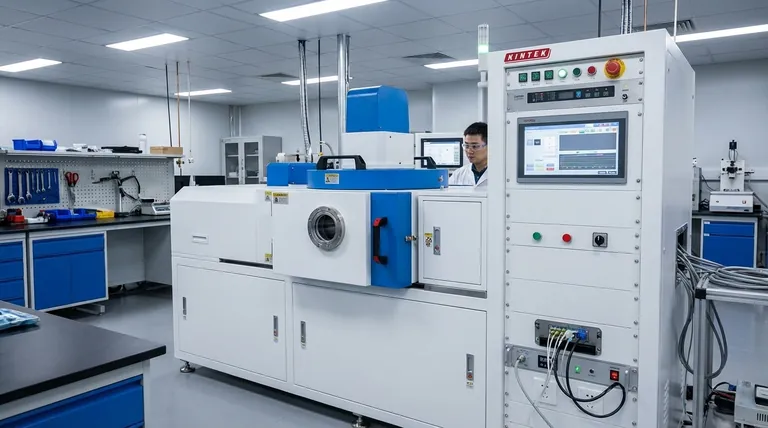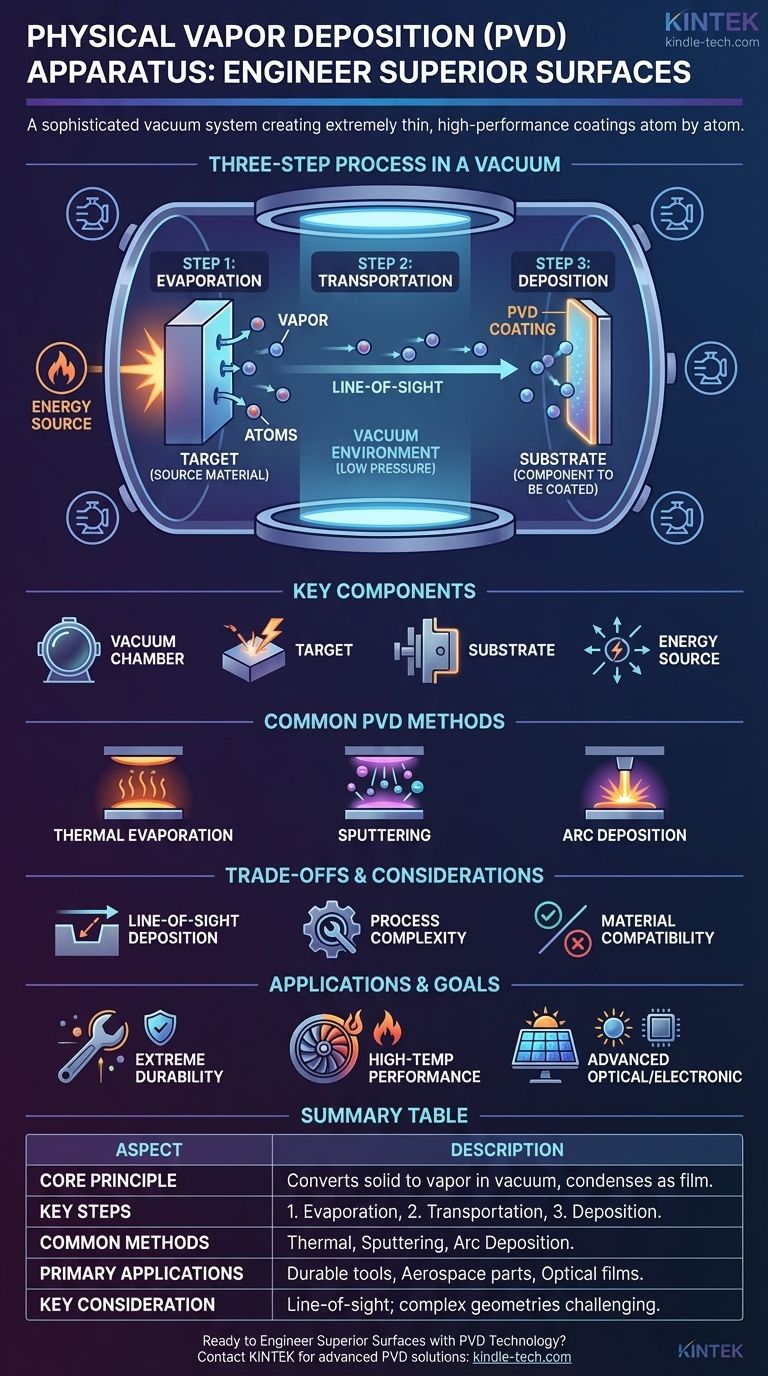In essence, a Physical Vapor Deposition (PVD) apparatus is a sophisticated vacuum system designed to create exceptionally thin, high-performance coatings on a surface. The machine works by taking a solid material, converting it into a vapor within a high-vacuum chamber, and then allowing that vapor to travel and condense onto a target object, or substrate. This process builds a new surface layer on the object atom by atom, resulting in a film with highly desirable properties.
The key to understanding a PVD apparatus is to see it not just as a machine, but as a system for controlling a fundamental physical process. It precisely manipulates a material's state—from solid to vapor and back to solid—within a controlled vacuum to engineer a surface with new capabilities.

The Core Principle: A Three-Step Process in a Vacuum
The entire PVD process is carried out at very low pressure (a high vacuum). This environment is critical because it removes air and other particles that could otherwise react with or impede the vaporized material as it travels from its source to the substrate.
Step 1: Evaporation (Creating the Vapor)
The process begins with the solid coating material, known as the target. This target is subjected to a high-energy source inside the vacuum chamber. The goal is to give the target's atoms enough energy to break free and enter a gaseous or vapor phase.
Step 2: Transportation (Moving the Vapor)
Once vaporized, the atoms or molecules of the coating material travel in a straight line through the vacuum chamber. The absence of air ensures a clear path to the substrate, preventing unwanted chemical reactions and collisions that would disrupt the formation of a pure, uniform film.
Step 3: Deposition (Building the Film)
The vaporized material strikes the surface of the substrate, which is typically at a lower temperature. Upon contact, the vapor rapidly cools, condenses, and solidifies, forming a thin, dense, and tightly bonded film on the substrate's surface. This coating is built up layer by layer, often just a few atoms at a time.
Key Components of a PVD Apparatus
While designs vary, all PVD systems contain several fundamental components that enable this precise process.
The Vacuum Chamber
This is the sealed enclosure where the entire process takes place. It's designed to be pumped down to a very high vacuum, creating the pristine environment necessary for high-quality coating.
The Target (Source Material)
This is the solid material that will ultimately become the coating. It is mounted inside the chamber and can be in the form of a solid block, plate, or rod, depending on the specific PVD method being used.
The Substrate (The Component to be Coated)
This is the object or part onto which the thin film is deposited. Substrates are carefully cleaned and fixtured inside the chamber to ensure they are correctly positioned to receive the coating.
The Energy Source
This is the engine that drives the process by turning the solid target into a vapor. Different PVD methods are defined by their energy source, which can include simple heating elements, a high-voltage electric arc, plasma, or a focused electron beam.
Common PVD Methods
The category of PVD is defined by how the solid material is converted to vapor. Each method offers unique advantages for different materials and applications.
Thermal Evaporation
This is one of the simplest methods, where the target material is heated in the vacuum until it evaporates, much like boiling water. The heat can be applied through resistive heating or, for materials with very high melting points, a high-energy electron beam (e-beam).
Sputtering
Often referred to as "spraying," this method doesn't use heat to boil the material. Instead, an energized plasma bombards the target, physically knocking atoms off its surface. These dislodged atoms then travel to and deposit on the substrate.
Arc Deposition
In this technique, a low-voltage, high-current electric arc is struck on the target's surface. The immense energy of the arc spot vaporizes the target material into a highly ionized state, and this plasma is then guided toward the substrate to form the coating.
Understanding the Trade-offs and Considerations
While powerful, the PVD process has inherent characteristics that make it suitable for some applications over others.
Line-of-Sight Deposition
The vaporized material travels in a straight line from the source to the substrate. This means that PVD is a "line-of-sight" process, which can make it challenging to evenly coat complex shapes with deep recesses or undercuts without sophisticated part rotation.
Process Complexity
PVD systems are complex pieces of equipment. Achieving and maintaining the required high vacuum, controlling the energy sources, and ensuring substrate cleanliness require significant technical expertise and investment.
Material Compatibility
While PVD can handle materials with very high melting points that are difficult to process otherwise, the choice of target material and PVD method must be carefully matched to the desired film properties and the substrate itself.
How PVD is Applied to Specific Goals
The choice to use a PVD apparatus is driven entirely by the desired outcome for the final product.
- If your primary focus is extreme durability: PVD is used to apply hard, corrosion-resistant coatings to cutting tools, industrial molds, and engine components to dramatically extend their operational life.
- If your primary focus is high-temperature performance: It is used in the aerospace industry to apply dense, temperature-resistant ceramic coatings to turbine blades and other parts that must withstand extreme heat.
- If your primary focus is advanced optical or electronic properties: PVD is essential for applying the precise, multi-layered optical films used in solar panels, architectural glass, and semiconductor manufacturing.
Ultimately, a PVD apparatus is a tool for fundamentally re-engineering a material's surface, enabling performance characteristics that the base material alone could never achieve.
Summary Table:
| Aspect | Description |
|---|---|
| Core Principle | Converts a solid target material into a vapor in a vacuum, which then condenses to form a thin film on a substrate. |
| Key Steps | 1. Evaporation (Vapor Creation) 2. Transportation (Vapor Travel) 3. Deposition (Film Formation) |
| Common Methods | Thermal Evaporation, Sputtering, Arc Deposition |
| Primary Applications | Durable tool coatings, high-temperature aerospace parts, advanced optical/electronic films |
| Key Consideration | Line-of-sight process; can be challenging for complex geometries without part rotation. |
Ready to Engineer Superior Surfaces with PVD Technology?
KINTEK specializes in advanced lab equipment, including solutions for precise thin-film deposition. Whether you are developing more durable tools, high-performance aerospace components, or cutting-edge optical devices, our expertise can help you achieve the exact surface properties you need.
Contact our experts today to discuss how our PVD solutions can enhance your research and production outcomes.
Visual Guide

Related Products
- RF PECVD System Radio Frequency Plasma-Enhanced Chemical Vapor Deposition RF PECVD
- Chemical Vapor Deposition CVD Equipment System Chamber Slide PECVD Tube Furnace with Liquid Gasifier PECVD Machine
- Split Chamber CVD Tube Furnace with Vacuum Station Chemical Vapor Deposition System Equipment Machine
- VHP Sterilization Equipment Hydrogen Peroxide H2O2 Space Sterilizer
- Molybdenum Tungsten Tantalum Special Shape Evaporation Boat
People Also Ask
- What are the advantages of PECVD? Enable Low-Temperature, High-Quality Thin-Film Deposition
- What are the applications of PECVD? Essential for Semiconductors, MEMS, and Solar Cells
- How does RF power create plasma? Achieve Stable, High-Density Plasma for Your Applications
- What are the benefits of PECVD? Achieve Superior Low-Temperature Thin Film Deposition
- Why does PECVD commonly use RF power input? For Precise Low-Temperature Thin Film Deposition



















